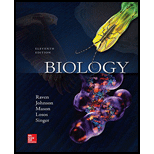
Concept explainers
Paracrine signaling is characterized by ligands that are
a. produced by the cell itself.
b. secreted by neighboring cells.
c. present on the plasma membrane of neighboring cells.
d. secreted by distant cells.
Introduction:
Cells can communicate with each other by various mechanisms such as direct contact, paracrine signaling, endocrine signaling and synaptic signaling.
Answer to Problem 1U
Correct answer:
Paracrine signaling is characterized by the ligands that are secreted by neighboring cells. Therefore, option b. is correct.
Explanation of Solution
Reason for the correct statement:
The paracrine signaling is a type of cell-cell communication in which a cell produces signaling molecules (ligands) that diffuse through the extracellular matrix to affect cells present in the nearby areas.
Option b. is given as “secreted by neighboring cells”.
As “paracrine signaling involves secretion of ligands by the neighboring cells”, is the right answer.
Hence, option b. is correct.
Reason for the incorrect statements:
Option a. is given as “produced by the cells itself”.
In autocrine signaling, the ligands produced by a cell bind to its own receptor. So, it is a wrong answer.
Option c. is given as “present on the plasma membrane of neighboring cells”.
In direct signaling, the ligand present on a cell bind to a receptor present on the plasma membrane of a neighboring cell. So, it is a wrong answer.
Option d. is given as “secreted by distant cells”.
In endocrine signaling, a cell produces ligands that enter the circulatory system to act on the distant target cells. So, it is a wrong answer.
Hence, options a., c, and d. are incorrect.
Paracrine signaling involves secretion of ligands that acts on the target cells present in the neighboring areas.
Want to see more full solutions like this?
Chapter 9 Solutions
Biology
- Which of the following is not a DNA binding protein? 1. the lac repressor protein 2. the catabolite activated protein 3. the trp repressor protein 4. the flowering locus C protein 5. the flowering locus D protein 6. GAL4 7. all of the above are DNA binding proteinsarrow_forwardWhat symbolic and cultural behaviors are evident in the archaeological record and associated with Neandertals and anatomically modern humans in Europe beginning around 35,000 yBP (during the Upper Paleolithic)?arrow_forwardDescribe three cranial and postcranial features of Neanderthals skeletons that are likely adaptation to the cold climates of Upper Pleistocene Europe and explain how they are adaptations to a cold climate.arrow_forward
- Biology Questionarrow_forward✓ Details Draw a protein that is embedded in a membrane (a transmembrane protein), label the lipid bilayer and the protein. Identify the areas of the lipid bilayer that are hydrophobic and hydrophilic. Draw a membrane with two transporters: a proton pump transporter that uses ATP to generate a proton gradient, and a second transporter that moves glucose by secondary active transport (cartoon-like is ok). It will be important to show protons moving in the correct direction, and that the transporter that is powered by secondary active transport is logically related to the proton pump.arrow_forwarddrawing chemical structure of ATP. please draw in and label whats asked. Thank you.arrow_forward
- Outline the negative feedback loop that allows us to maintain a healthy water concentration in our blood. You may use diagram if you wisharrow_forwardGive examples of fat soluble and non-fat soluble hormonesarrow_forwardJust click view full document and register so you can see the whole document. how do i access this. following from the previous question; https://www.bartleby.com/questions-and-answers/hi-hi-with-this-unit-assessment-psy4406-tp4-report-assessment-material-case-stydu-ms-alecia-moore.-o/5e09906a-5101-4297-a8f7-49449b0bb5a7. on Google this image comes up and i have signed/ payed for the service and unable to access the full document. are you able to copy and past to this response. please see the screenshot from google page. unfortunality its not allowing me attch the image can you please show me the mathmetic calculation/ workout for the reult sectionarrow_forward
 Biology: The Dynamic Science (MindTap Course List)BiologyISBN:9781305389892Author:Peter J. Russell, Paul E. Hertz, Beverly McMillanPublisher:Cengage Learning
Biology: The Dynamic Science (MindTap Course List)BiologyISBN:9781305389892Author:Peter J. Russell, Paul E. Hertz, Beverly McMillanPublisher:Cengage Learning Human Physiology: From Cells to Systems (MindTap ...BiologyISBN:9781285866932Author:Lauralee SherwoodPublisher:Cengage Learning
Human Physiology: From Cells to Systems (MindTap ...BiologyISBN:9781285866932Author:Lauralee SherwoodPublisher:Cengage Learning Biology (MindTap Course List)BiologyISBN:9781337392938Author:Eldra Solomon, Charles Martin, Diana W. Martin, Linda R. BergPublisher:Cengage Learning
Biology (MindTap Course List)BiologyISBN:9781337392938Author:Eldra Solomon, Charles Martin, Diana W. Martin, Linda R. BergPublisher:Cengage Learning Human Biology (MindTap Course List)BiologyISBN:9781305112100Author:Cecie Starr, Beverly McMillanPublisher:Cengage Learning
Human Biology (MindTap Course List)BiologyISBN:9781305112100Author:Cecie Starr, Beverly McMillanPublisher:Cengage Learning





